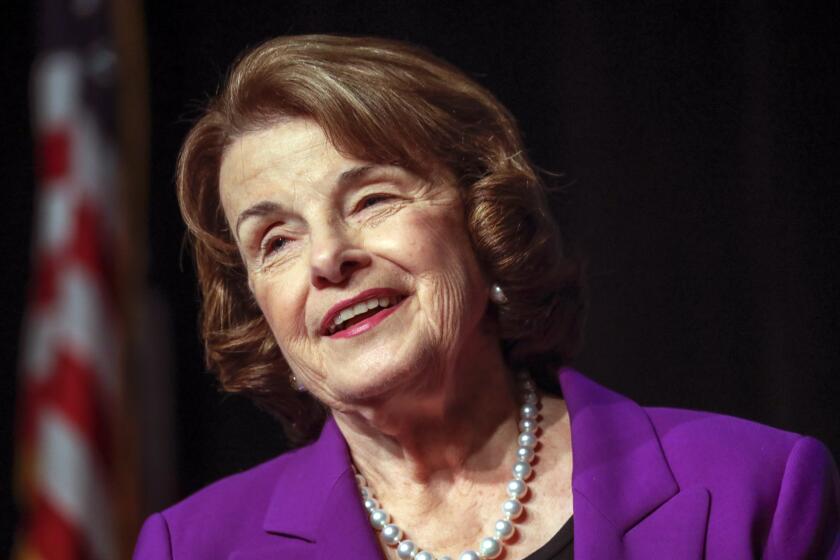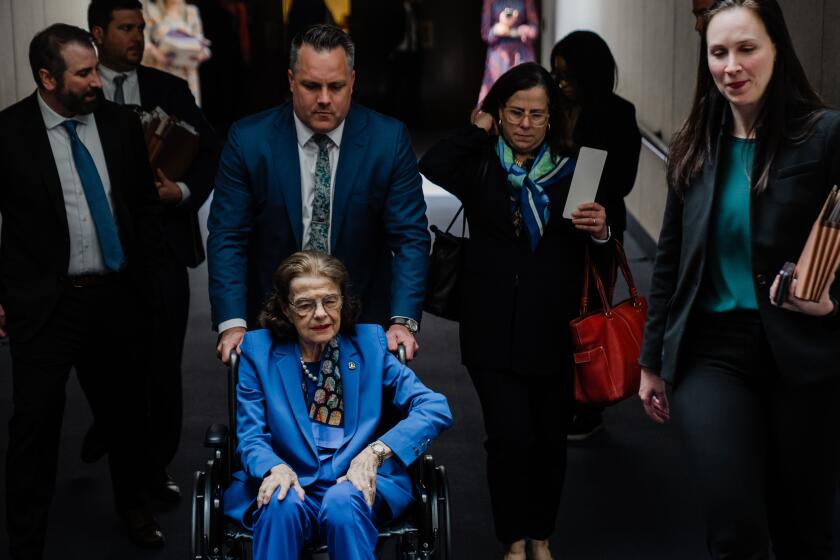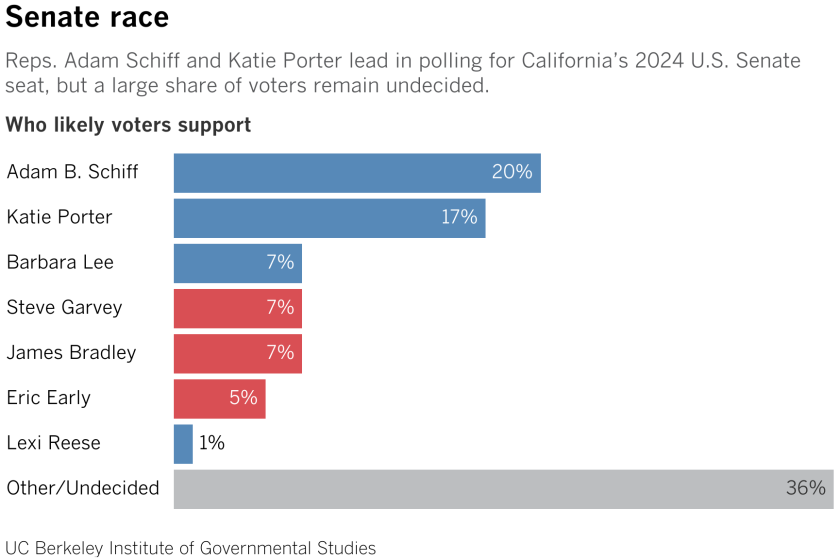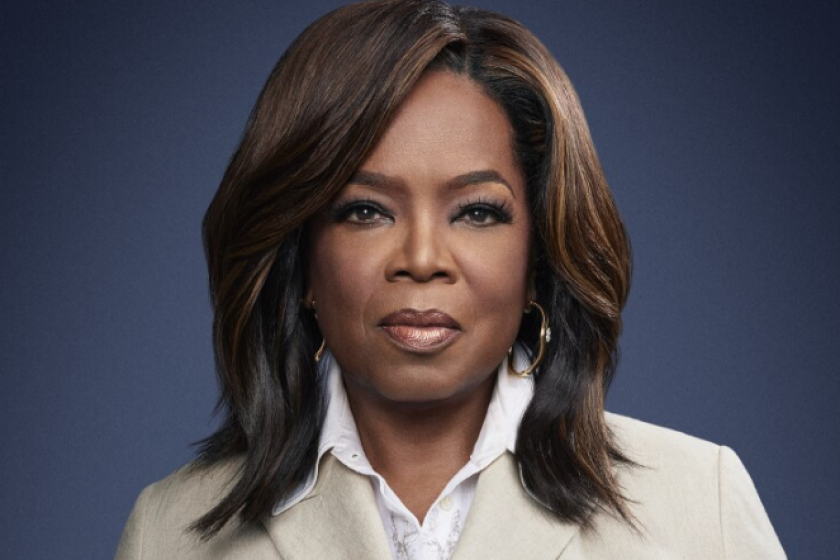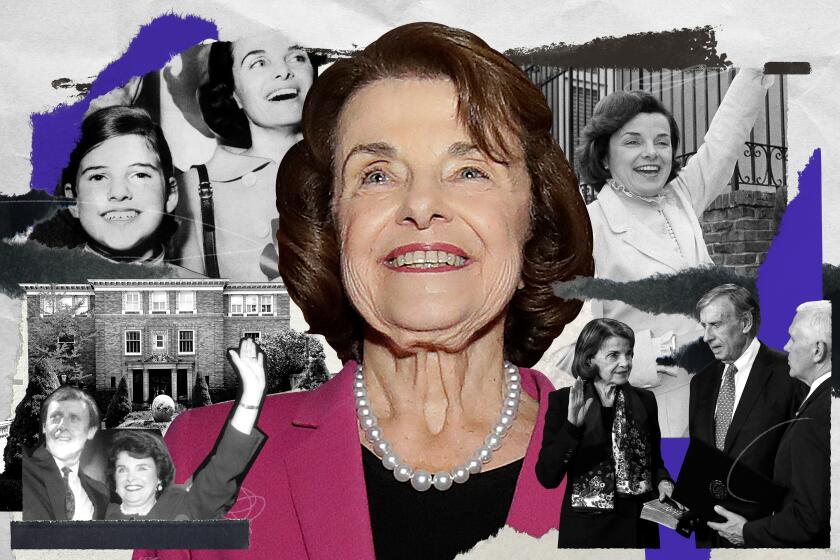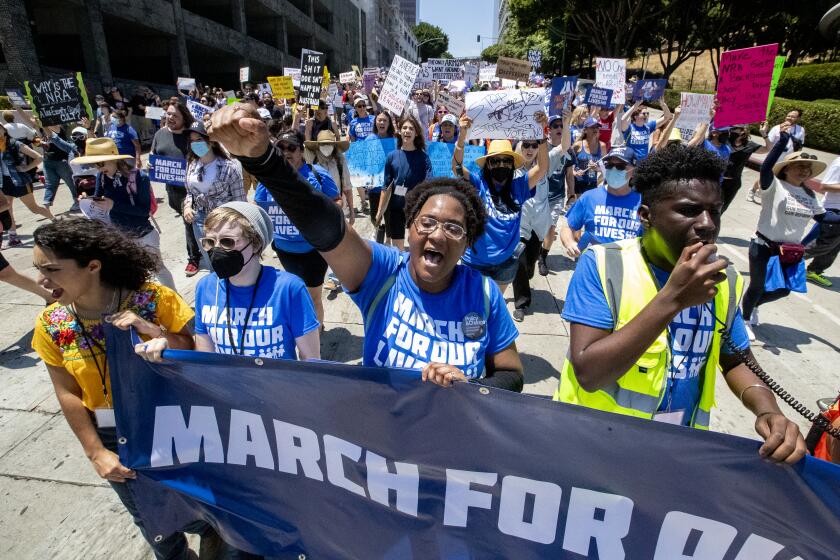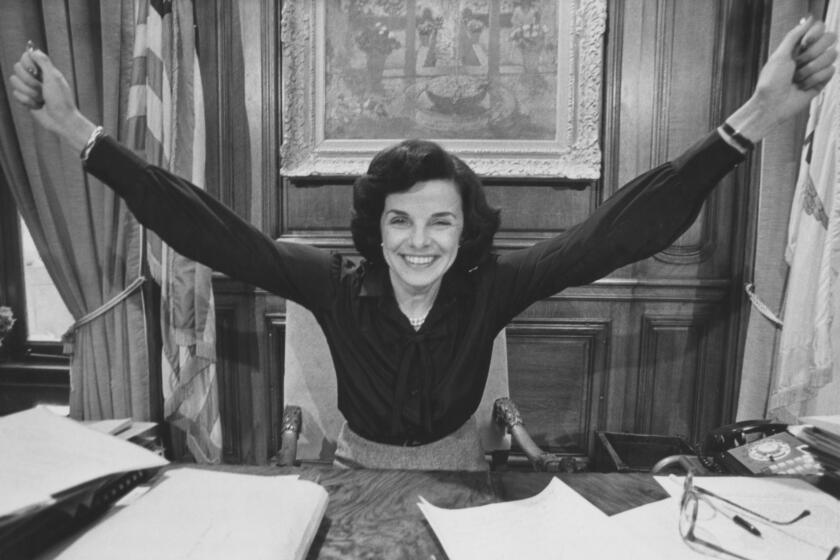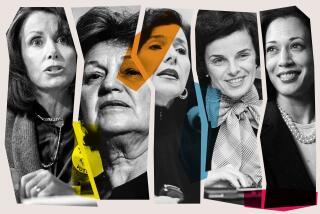Dianne Feinstein, the first woman to represent California in the Senate, dies at 90
- Share via
U.S. Sen. Dianne Feinstein survived an assassination attempt and a mayoral recall effort to become the most popular politician in California for years running.
- Share via
Dianne Feinstein, who surmounted an abusive childhood and early political failures to become the first woman to represent California in the Senate and a central figure in the rise of women to national political power, has died. She was 90.
“Sadly, Senator Feinstein passed away last night at her home in Washington, D.C.,” her chief of staff, James Sauls, said in a statement Friday morning. “Her passing is a great loss for so many, from those who loved and cared for her to the people of California that she dedicated her life to serving.”
For the record:
12:10 p.m. Sept. 29, 2023An earlier version of this article said Dianne Feinstein was the target of two assassination attempts. There was one attempt.
Feinstein was the oldest member of the U.S. Senate when she died, and questions about her mental capacity shadowed her final years in office, blemishing her reputation and forcing her to repeatedly fend off calls to resign.
“I’d put my record up against anyone’s,” Feinstein said in a statement as she neared her 89th birthday in April 2022, after a series of news accounts that questioned her ability to do her job.
She ultimately bowed to age and political reality, announcing in February that she would not seek reelection in 2024 to a sixth full term. By then, the race to succeed her was already underway.
Feinstein’s last Senate vote was cast at 11:45 a.m. Thursday, on a bill aimed at preventing a government shutdown. She missed two votes later in the day.
Political leaders in Washington and across the country recalled Sen. Dianne Feinstein as a trailblazer and an early voice for gun control.
On Friday, a bouquet of white roses was placed on Feinstein’s seat in the Senate chamber, where Majority Leader Charles E. Schumer (D-N.Y.) grew emotional speaking of his late colleague, calling her “one of the most amazing people who ever graced the Senate.” He added: “Her integrity was a diamond.”
President Biden hailed Feinstein as “a pioneering American. A true trailblazer. And for Jill and me, a cherished friend.”
He said in a statement that Feinstein was a woman who “made history in so many ways. ... Dianne was tough, sharp, always prepared, and never pulled a punch, but she was also a kind and loyal friend, and that’s what Jill and I will miss the most.”
After two unsuccessful attempts to be elected mayor of San Francisco, Feinstein stepped into the job under dire circumstances following the 1978 assassination of her predecessor, George Moscone, and Supervisor Harvey Milk by a political colleague.
From that unanticipated perch, she was considered for a Democratic vice presidential nomination in 1984, and six years later became the first woman nominated by a major party for governor of California.
She lost, but rebounded two years later to claim the Senate seat that she would hold for more than three decades, becoming the longest-serving woman in the Senate.
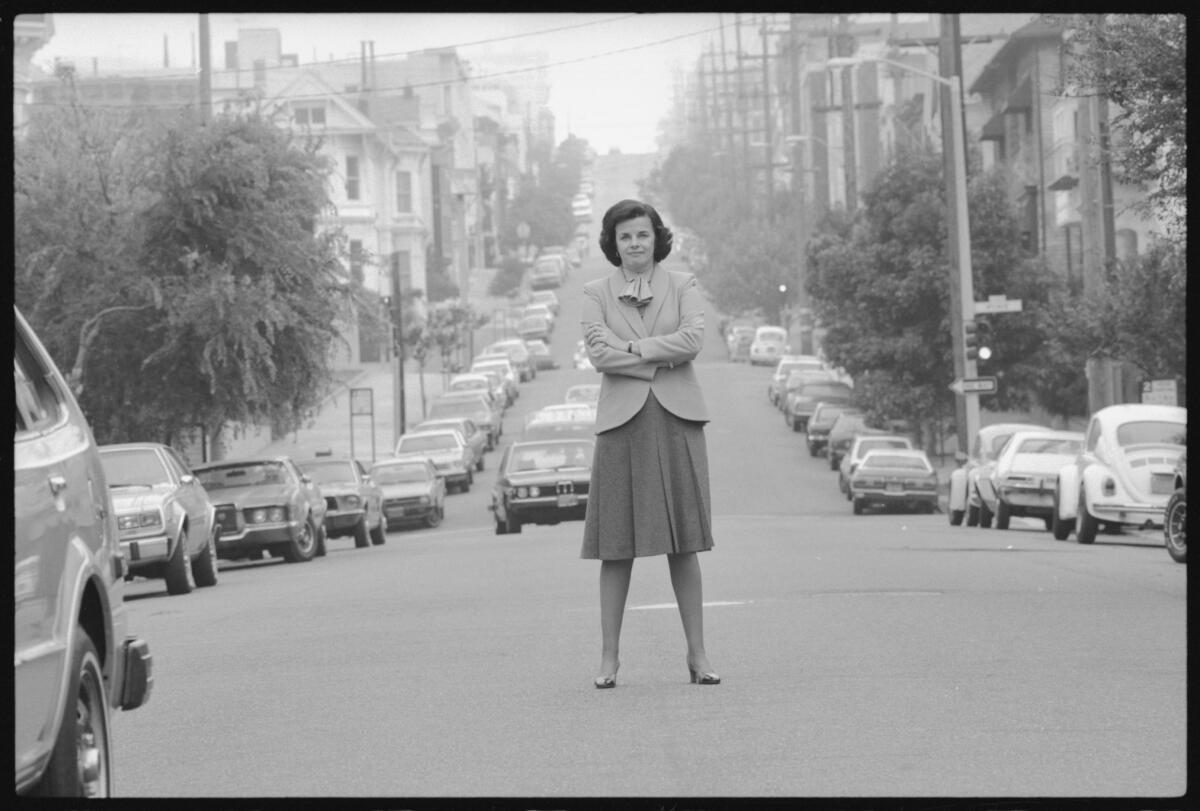
Feinstein’s Senate career was marked by hard-fought accomplishments, including a landmark 1994 bill banning certain semiautomatic firearms, an issue she continued to press after its expiration 10 years later. While generally liberal, she hewed to a flinty pragmatism even when that grew increasingly out of fashion in her party as it moved to the left.
She won her Senate seat in 1992’s “Year of the Woman” election, an accomplishment that masked Feinstein’s ambivalence toward gender politics. She was the first woman to serve on the Senate’s Judiciary Committee and Select Committee on Intelligence. But with isolated exceptions, she avoided rhetorical barricades in favor of negotiation and compromise.
“That’s what we need — people who understand working together isn’t a bad word and achieving together isn’t a bad word,” she told a Los Angeles crowd in 2017. “We do need to compromise and that is not a bad word.”
She could seem imperious and regal in public, but as mayor carried a firefighter’s coat in her trunk to wear in emergencies. She was the target of an assassination attempt and a mayoral recall effort, surviving to become the most popular politician in the state for years running.
Dianne Feinstein’s daughter Katherine has argued her mother is owed millions from her late husband’s estate and needs the money now to cover medical bills.
Dianne Emiel Goldman was born on June 22, 1933, in San Francisco. Her father, Leon, broke barriers of discrimination against Jews to become a renowned physician at San Francisco General Hospital and a professor at UC San Francisco. He met Feinstein’s mother, Betty, when she was caring for a sick friend who was one of his patients. Her father was mild-mannered, scholarly and a perfectionist — the latter a trait passed on to his eldest daughter.
Her mother could be volatile, flying into mystifying rages. Feinstein, the eldest of three girls, told a reporter that her mother had chased her around the dining room table with a carving knife. Her sister Lynn’s first memory was their mother’s attempt to drown her in the bathtub.
“We lived in a great deal of fear,” Feinstein once said. “Whatever we did, we couldn’t please her.”
It was a shame-kept secret. The family lived in San Francisco’s affluent Presidio Terrace, and to the outside world presented the picture of a stable, well-to-do family. It would not be known until years later that her mother suffered from brain damage, possibly caused by encephalitis and made worse by alcoholism.
The night before Feinstein was to take her SAT, her mother kicked her out of the house. She spent the night in the family car, prepping for the exam. She nonetheless got into Stanford, class of 1955. In her senior year there, she wanted to run for student body president, but no woman had ever been elected to the office at Stanford. Showing the pragmatism of her later years, she opted to run for vice president.
The possibility of former Dodger Steve Garvey entering the Senate race hasn’t changed the top-two dynamic, a new UC Berkeley/Los Angeles Times poll shows.
She graduated with a degree in history and applied for an internship at the Coro Foundation, which connected young people with jobs in politics and government. On her application, she wrote: “I plan to run for political office on a local and possibly a national level.”
The foundation placed her in Democrat George Reilly’s 1955 campaign for the ostensibly nonpartisan job of mayor of San Francisco. Reilly lost, and two months later Coro assigned her to a study project on criminal justice, reporting to San Francisco prosecutor Jack Berman. She and Berman fell in love, and over her parents’ objections eloped to Los Angeles.
When their daughter, Katherine, was 2, Feinstein and Berman divorced, bitterly.
She was 26, a single mother, uncertain of her future.
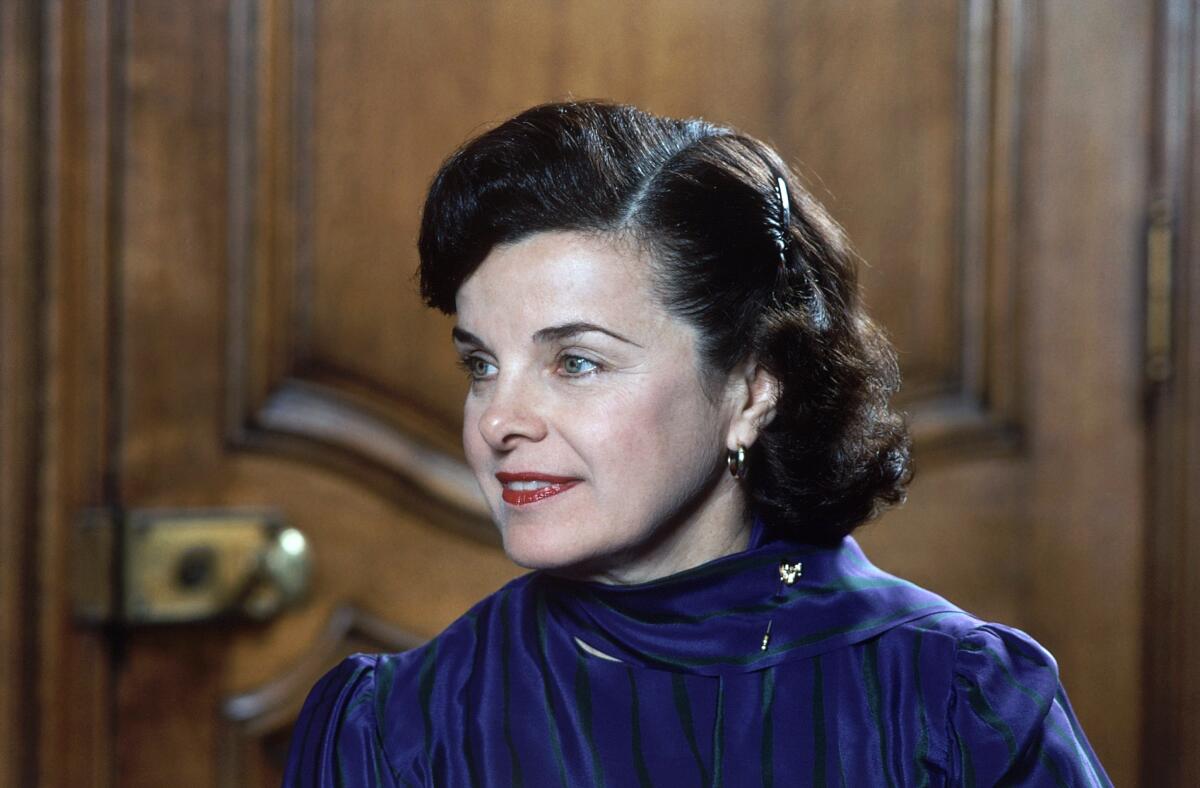
Pushing the toddler in a stroller, she demonstrated for civil rights, campaigned for John F. Kennedy and picketed a developer who refused to let Willie Brown, a young Black attorney, tour a model home. Brown would go on to become a powerhouse in California politics — and a political supporter of Feinstein.
Her life changed on Christmas in 1961, when she took her daughter to a holiday party. After Katherine wandered off among the guests, her mother found the 4-year-old talking earnestly with Bertram Feinstein, a neurosurgeon. On their first date, at a fancy French restaurant, he proposed to the young mother. In November 1962, they were married by a rabbi at her rented house.
By then, Feinstein was becoming deeply involved in crime and corrections issues. Gov. Edmund G. “Pat” Brown had appointed her to a state women’s prison board, which she wrote about in a series for the San Francisco Examiner. She also wrote detailed, sometimes graphic reports on local jail conditions as leader of San Francisco’s adult detention advisory panel.
In 1968, Mayor Joseph Alioto named her to a blue-ribbon committee on crime. She served, but wanted to do more. The next year she announced she would seek a seat on the San Francisco Board of Supervisors.
Running as simply “Dianne” gave Feinstein easy name recognition. She raised more money than her rivals and outspent them all, cultivating her political connections and drawing in outsiders, including a slow-growth, anti-Manhattanization movement and supporters in the LGBTQ+ community.
That first campaign in 1969 displayed what would become her political hallmarks: She was a centrist who leaned left. She wanted to fight crime. She also wanted to protect the environment. She wanted to improve education but opposed raising property taxes to pay for it.
Get our L.A. Times Politics newsletter
The latest news, analysis and insights from our politics team.
You may occasionally receive promotional content from the Los Angeles Times.
Eighteen candidates were running for five seats. Five were incumbents. On election night, she finished first, to her own surprise. As a supervisor, she twice ran for mayor, coming in third each time.
It was a time of extraordinary violence in the Bay Area. In what became known as the Zebra murders, a splinter group of Black Muslims killed at least 15 people at random and tried to kill at least eight others. In Sacramento and again in San Francisco, would-be assassins targeted President Ford. The Symbionese Liberation Army kidnapped newspaper heiress Patty Hearst from her Berkeley apartment. Police assigned Feinstein’s daughter a bodyguard, fearing she might be next.
Feinstein and other county supervisors were targeted by the New World Liberation Front, an anti-capitalist group suspected of 70 bombings. Two supervisors had candy boxes stuffed with dynamite delivered to their homes. At 2 a.m. one night, Katherine heard popping outside her window. When daylight came, she found a bomb whose detonator had malfunctioned. Not long afterward, windows were shot out at the Feinsteins’ coastal vacation home. Feinstein got a gun permit and began carrying a .38-caliber pistol in her purse.
Before long, Feinstein’s husband was diagnosed with colon cancer; Bertram Feinstein would die in 1978, a loss that crushed her. Meanwhile, quarreling among supervisors was getting worse, and Feinstein told a colleague she was sick of it. With Katherine off at college, she was alone and lonely, and pondered leaving politics.
Later that year, Feinstein got a call from investment banker Richard Blum, who had been named to head the city’s Fiscal Advisory Committee. Blum, recently divorced, wanted to discuss the budget. During a break in a board meeting they had dinner in Sausalito, and were soon an item.
Blum died at the family home after a long battle with cancer, the senator’s office said.
By then, there had been serious upheaval at City Hall. Dan White, a conservative ex-cop turned fireman, was unhappy as a supervisor, finding it hard to deal with some of his colleagues, especially the liberal Harvey Milk, the first out gay man elected to public office in California, and one of the first in the country. By law, White had to quit the Fire Department when he was elected, and his family wasn’t getting by on a supervisor’s pay. After a faltering effort to start a business, he resigned.
Within a week, White changed his mind, but his fate was in the hands of Mayor George Moscone. Milk and others helped persuade the mayor to replace White with a Moscone supporter, a decision White heard about from a reporter.
On Nov. 27, 1978, White loaded five bullets into a .38 revolver he had kept from his days on the police force. He put 10 more bullets into a pocket of his suit coat and headed for City Hall.
There, White avoided security by climbing in through a basement window. At Moscone’s office, he asked a secretary whether he could see the mayor. Moscone buzzed him in. Shots rang out. As White rushed out of Moscone’s office and toward Milk’s, Feinstein spotted him.
“I was looking for Dan and he whipped by, and I said, ‘Dan!’ and he said ‘In a minute,’” Feinstein recounted at a Town Hall Los Angeles meeting years later. “And I heard the door slam. I heard the shots. I smelled the cordite. I went out of my office, Dan rushed right by me, and I walked into Harvey’s office.”
Feinstein tried to find his pulse. Instead, she found a bullet hole.
Soon after, Feinstein stood in a corridor at the top of three marble steps. Looking stricken but calm, she spoke briefly, words that would one day introduce her to California voters.
“As president of the Board of Supervisors,” she said, “it is my duty to inform you that both Mayor Moscone and Supervisor Harvey Milk have been shot and killed.”
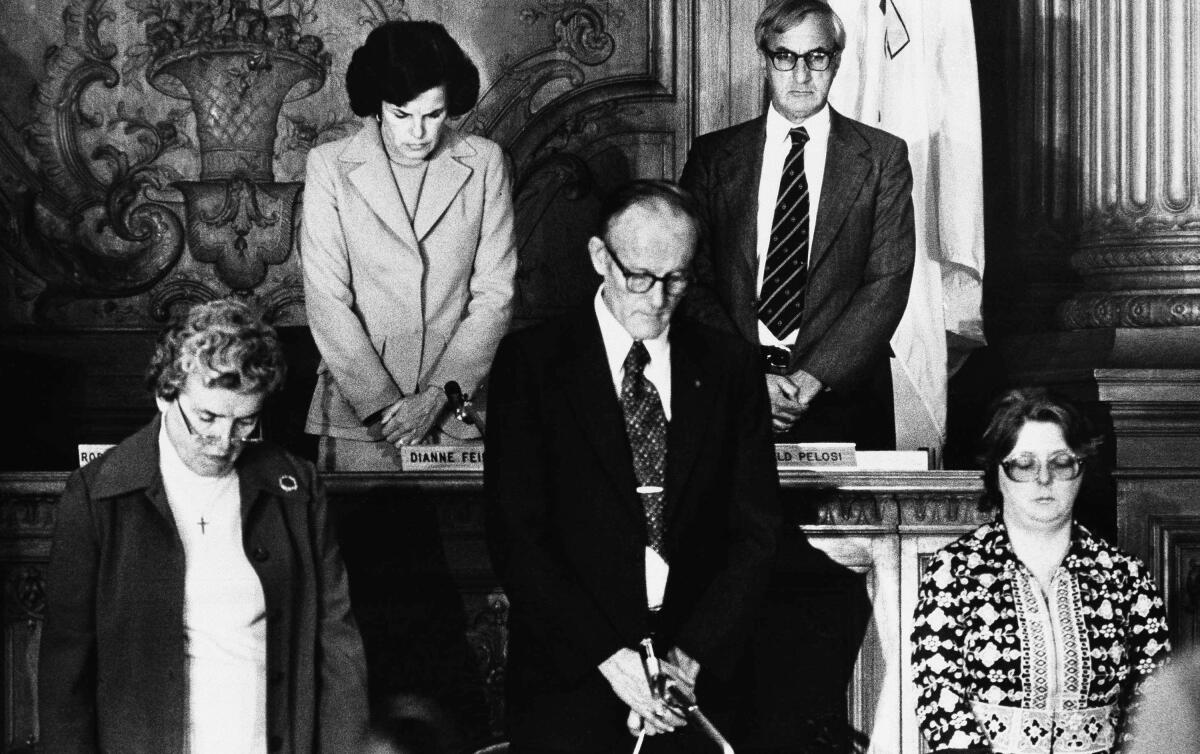
She insisted on holding a scheduled supervisors’ meeting so that San Franciscans would know their government was not in disarray. Milk’s seat was empty. So was White’s. After a few words and a silent prayer, Feinstein rapped her gavel and left.
Moments before, White had walked into a police station and surrendered.
That night, tens of thousands, their lighted candles held high, marched to City Hall in a passionate tribute to Milk. Joan Baez sang “Amazing Grace,” and Feinstein spoke. Two days later, the sky heavy with clouds, she took the microphone again on the City Hall steps and led San Francisco in a ceremony eulogizing its slain leaders.
Those days defined Feinstein. Before then, California political analyst Sherry Bebitch Jeffe said, “You didn’t see a woman take control the way she did, in an executive position. She didn’t dissolve in tears and scream and yell. She was in control. That added a lot to her ability to win when she did.”
The Board of Supervisors chose Feinstein as the city’s first female mayor. She would serve the rest of Moscone’s term.
Oprah Winfrey’s spokeswoman on Thursday threw cold water on the idea that Winfrey could be appointed to replace Sen. Dianne Feinstein, should she retire, saying she “is not considering the seat should it become vacant.”
Five months after the slayings, White went on trial. His attorney acknowledged that White had shot Moscone and Milk, but said he suffered from depression and could not have acted with premeditation, as required for a murder conviction.
A defense psychiatrist said White’s depression included bingeing on sugary foods. Jurors bought the argument, which became known as “the Twinkie defense,” and convicted White of voluntary manslaughter. He would serve less than five years in prison, and in 1985 would kill himself.
Anger at the jury’s lenience swept through San Francisco, especially its gay community. Feinstein condemned the verdict and urged the city to stay calm. Then she went home. It was a critical mistake.
Thousands of protesters stormed City Hall. They threw rocks, trash cans, newspaper racks, parking meters and street signs. Police in riot gear stood their ground, but Chief Charles Gain ordered them not to scatter the crowd. That would cause injuries, Gain believed, and spread the violence.
Feinstein returned to City Hall during the protest. Outside her second-floor office balcony, she heard glass break and people chant, “Kill Dan White.” She stayed inside and deferred to police. Finally, officers dispersed the crowd and took revenge, taunting gay protesters, beating news reporters and bystanders, and forcing their way into a gay bar, where they clubbed patrons.
During the hours of chaos, 65 police officers and dozens of civilians were injured, and $400,000 worth of property was destroyed, including 14 police cars. The riot came to be called White Night. When Feinstein later vacillated over whether to fire the police chief, any early goodwill she enjoyed as mayor evaporated.
The chaos of White Night gave ammunition to her 1979 election opponent, Quentin Kopp. But a bitter campaign ended with her election as mayor. A month later, she and Richard Blum were married in her chambers.
Throughout her long career, California’s Sen. Dianne Feinstein had maintained a polished public image. Now her personal affairs have come flooding into public view.
Feinstein won a second term in a landslide vote, and was named one of America’s 10 most influential women. In 1984, when Democrats held their national convention in San Francisco, she shared the cover of Time magazine with Rep. Geraldine Ferraro of New York, whom Democratic presidential nominee Walter Mondale ultimately chose as his running mate.
Limited to two elected terms as mayor, Feinstein left office on Jan. 8, 1988. A poll showed that two-thirds of registered voters thought she had done a good or excellent job.
After a frustrating year on the political sidelines, she was intrigued when Gov. George Deukmejian announced that he would not seek a third term in 1990.
Feinstein’s quest to become the state’s first female governor opened inauspiciously.
She had never run statewide. She had no office and no campaign staff. She had no presence in Southern California, the state’s population center, and she had repeatedly postponed surgery for fibroid tumors that were sapping her energy.
She finally underwent surgery, but was trailing the expected Democratic front-runner, state Atty. Gen. John Van de Kamp, a Southern Californian who had the support of the party’s biggest factions. At her Presidio Terrace mansion in November 1989, her strategists searched for some way to turn the race around. Digging through her files, they found it.
It was a TV documentary about the killings of Moscone and Milk, which began with a news clip of Feinstein announcing the assassinations. It became her introductory ad — called “the grabber” because no one could look away.
On Feb. 5, 1990, four months before the gubernatorial primary, Feinstein formally declared her candidacy. Within days, courtesy of the ad, polls showed she had pulled ahead of Van de Kamp.
The primary was fierce, with the party split by both gender and geography. Van de Kamp blamed Feinstein for San Francisco’s $172-million budget deficit and raised questions about her husband’s investments. Feinstein hewed to the center-right, and again declined to focus much on her gender. A Van de Kamp supporter, then-Rep. Barbara Boxer, called him “the best feminist in this race.”
The criticism rankled.
“I had to quit a job because there was no maternity leave,” she told Time magazine. “I raised a child as a single mother … I’ve lived it.”
Her slogan — “tough and caring” — hit home. She held her lead among men and opened a wide margin among women. For good measure, she aired an ad featuring a body bag to accuse Van de Kamp of bungling the Hillside Strangler case when he was Los Angeles district attorney. On primary day, June 5, 1990, she swamped Van de Kamp 52% to 41%, becoming the first woman to win a major-party nomination for governor of California.
Now, though, she had to beat Pete Wilson, a sitting U.S. senator and former San Diego mayor whom Republican leaders had implored to enter the race.
As a senator, Wilson had helped then-Mayor Feinstein obtain federal funds for projects in San Francisco, and she had thanked him in a letter in which she wrote: “You’re wonderful.” He displayed the note in a TV spot that began airing the day after the primary, when Feinstein was exhausted and her campaign out of money.
“I guess,” she sneered in response, “men like to be told they’re wonderful.”
When Feinstein pledged “gender balance” in appointments to state jobs, Wilson countered with a TV ad that called her promises “quotas.” Feinstein dropped dramatically in the polls.
She attacked Wilson for accepting large campaign contributions from the owners of savings and loans, an industry then rife with scandal. Wilson counterattacked by accusing Feinstein of benefiting personally from the S&L crisis. The nasty campaigning diluted her newcomer appeal, and she lost the election by 3.5 percentage points. But out of that loss, a career in the U.S. Senate would be born.
The day after the election, Democrat Alan Cranston, California’s veteran U.S. senator, announced he would not seek reelection in 1992 — the same year that Wilson’s appointed successor in the Senate, a little-known Orange County lawmaker named John Seymour, would have to run to keep his seat.
A reporter asked Feinstein whether she was interested. “My life has been public service,” she said. “It’s what I want to do.”
Feinstein opted to seek Seymour’s seat, hoping most candidates would be scared away by the need to run in both 1992 and 1994, when Wilson’s term was to end. Instead, Gray Davis, a former state lawmaker and controller and a future governor, jumped into the Democratic primary race, and accused Feinstein of being a secret Republican. But Davis’ campaign faltered when he went after her harshly, and she won the party’s nomination in a landslide.
This time, Feinstein was ready for the general election against Seymour. She had stepped up her fundraising, boosted her strategic team and visited swing areas of the state. Well before the race ended, the Democratic groundswell turned into a rout.
On Nov. 3, 1992, both Feinstein and Boxer, the latter running for Cranston’s seat, were elected to the U. S. Senate, becoming the first pair of women to represent a state simultaneously. Because she was replacing an appointee, Feinstein was sworn in first.
“I think we dispelled a number of myths about women running,” Feinstein said. “I think people are basically more interested in what you represent, your values, your judgment, the platform that you put forward.”
Several months into her first term, Feinstein celebrated her 60th birthday at the White House. President Clinton presented her with a cake covered in butter brickle frosting.
Less than a year later, she became one of the first Democrats to publicly criticize his healthcare plan. Later, she was one of the first Democrats to chastise him for his affair with Monica Lewinsky. And she voted for Clinton’s deficit-reduction package only after admonishing the administration to help California economically and extracting concessions.
Early legislative victories came in a measure to protect the California desert, a major environmental initiative that had been stalled for years. The California Desert Protection Act set aside millions of acres of land, half of it in national parks and a national preserve. During negotiations, Feinstein made more than 60 changes to the bill, cementing a reputation as a deal maker.
Still, she often irked Democratic constituencies. Her party moved sharply to the left on immigration over her time in the Senate, but Feinstein maintained more centrist positions. She favored stiffer security at the border, punishment for those who illegally employed migrants, and penalties for the so-called coyotes who smuggled them into the United States.
In 2015, after a woman was killed on a San Francisco pier by a bullet that a man in the country illegally said was accidentally discharged from a gun he’d found, Feinstein criticized police for not working more closely with federal immigration officials to deport people like him. Pro-immigrant groups raged.
Feinstein also was criticized by liberals for her 2002 vote to authorize the Iraq war. Like a majority of the Senate, she put stock in the George W. Bush administration’s false assertions that Iraq had stockpiled weapons of mass destruction.
“It is the decision I regret most,” she said in 2017, “and I have to live with it.”
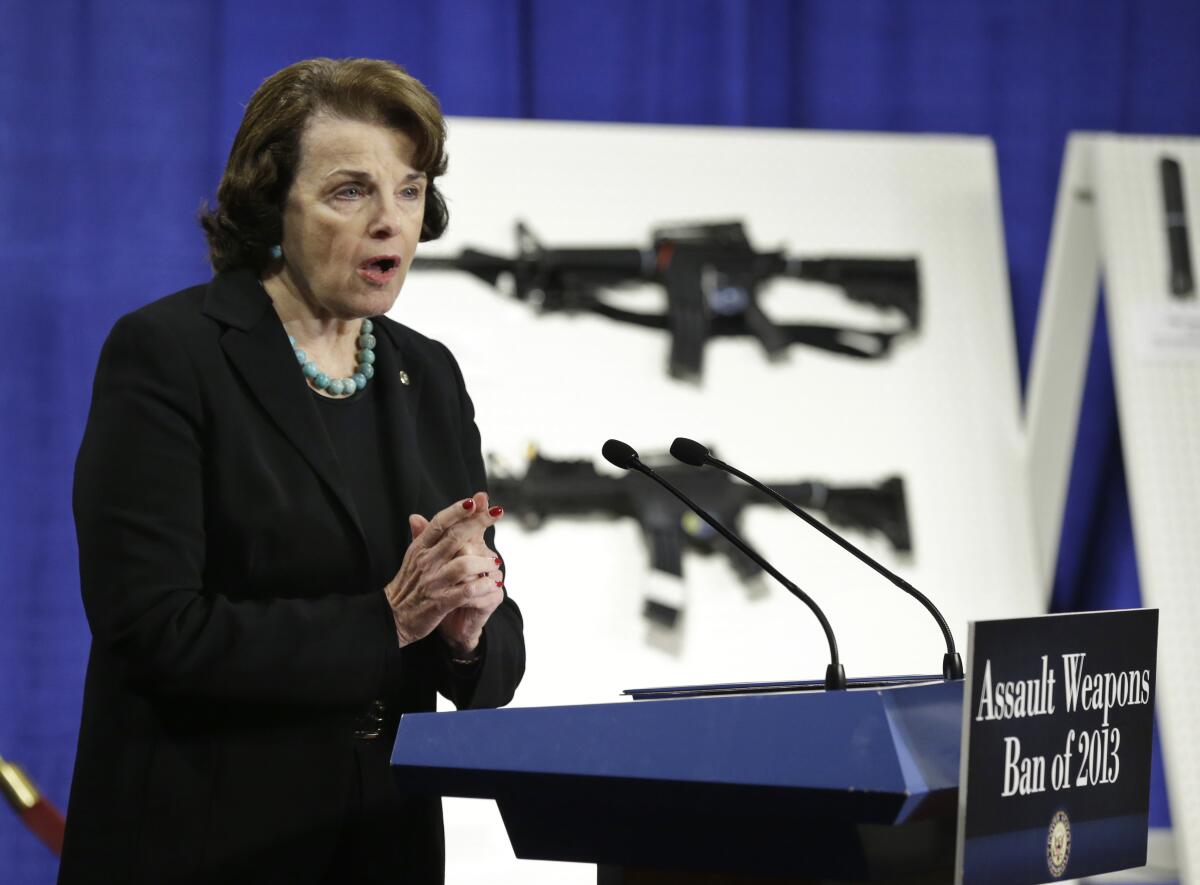
Two huge battles served as bookends to Feinstein’s tenure: the 1994 fight to curb the sale of assault weapons and her battle two decades later against the CIA’s use of torture against suspected enemies overseas. Feinstein seized on the gun issue early in her first term, angered by three separate mass killings in California, the last of which claimed eight people in a San Francisco office tower.
“It was the incident that really said, ‘By God, I may go down, but I’m going to try to make a difference,’” Feinstein said.
She told the Judiciary Committee chairman, then-Sen. Joe Biden (D-Del.), that she wanted to amend the 1994 crime bill to stop the manufacture, sale and possession of military-style weapons. The future president told her it was hopeless.
But she buttonholed other senators for input, and wrote a ban on 19 weapons and on ammunition clips that held more than 10 bullets. It navigated the concerns of recreational shooters, exempting existing weapons and protecting 650 sporting guns, including high-powered rifles and shotguns. She sent a draft to the National Rifle Assn. and asked for suggestions.
“What I got back,” she told The Times, “was nothing.”
The NRA, the most powerful lobby in American politics, mounted an attack against Feinstein and her cause. On the Senate floor, Larry Craig, a Republican from Idaho, patronized her: “The gentlelady from California needs to become a little more familiar with firearms.”
Feinstein locked eyes on Craig and recounted the morning when she had rushed to help Harvey Milk.
“Senator,” she said, “I know something about what firearms can do.”
The 1994 crime bill passed, and it included Feinstein’s amendment on so-called assault weapons, though the ban lapsed after 10 years.
After the 2012 massacre of 20 children and six adults at Sandy Hook Elementary School in Newtown, Conn., by a shooter carrying a similar weapon, Feinstein furiously told her fellow senators that it was time to “show some guts” and reinstate the ban. She renewed her demand in early 2018 after a shooting at a Parkland, Fla., high school claimed 17 lives.
Four years after a gunman shot up her high school, a young journalist finds herself writing about mass shootings again. In fact, she says, she never stopped.
“I’m tired of children getting shot,” she said in 2018. “We become culpable when we do nothing to stop it.”
Then, as after Sandy Hook, nothing changed.
Feinstein was arguably more successful when it came to what she called her most important work.
The senator had long been a sympathetic ally of the intelligence community. When Edward Snowden, a National Security Agency contractor, revealed that the agency was secretly collecting Americans’ communications records, Feinstein defended the NSA despite cries for change from civil libertarians and Democrats.
Yet if the CIA expected sympathetic treatment from her when it came to torture, it was wrong.
Feinstein came out against what intelligence and military officials called “enhanced interrogation techniques” in 2006, when their use in secret overseas prisons became known. Her call for a full investigation led to five years of efforts, by a revolving cast of intelligence officials, to block her work and keep the probe’s results secret.
The investigative report was more than 6,700 pages long, much of it classified. Feinstein insisted on holding the CIA accountable in a 525-page executive summary. After lengthy negotiations over what it could include, she released it on Dec. 9, 2014.
The senator was labeled a “traitor” by some, including Rep. Jeff Duncan, a Republican from South Carolina.
Feinstein maintained that she was expunging “a stain on our values and on our history,” that “torture goes against the very soul of our country,” and that “this is not what Americans do.”
“Anybody who reads this is going to never let this happen again,” she argued.
Toward the end of her career, the winds of change began to blow harder against Feinstein. After years of romping over Republican sacrificial lambs in elections, she was confronted in her quest for a sixth straight Senate victory in 2018 by her own restive party.
In a repudiation of the incumbent, the Democratic state Senate leader, Kevin de León, announced that he would challenge her in 2018 — her first party opponent since 1992. De León suggested that Feinstein was a vestige of a time gone by, too moderate, too old. Others in her party privately agreed and wondered whether she had overstayed her time in office.
Key moments in Dianne Feinstein’s boundary-breaking career in California politics
During a 2017 town hall in Los Angeles’ venerable First African Methodist Episcopal Church, members of the audience shouted at Feinstein: “You’re defending Trump!” She looked stunned, but remained long after the meeting, chatting with young women asking for advice about politics. Soon, without seeming to intend to, Feinstein was explaining what had kept her in politics for so many decades.
“I know the terrible things that happen and I know how to cure them,” she said. “And there’s only one way to do it, and that’s to work together.”
The following year, she held off De León and once again was reelected.
Feinstein is survived by her daughter, Katherine Feinstein, a retired San Francisco Superior Court judge; and a granddaughter, Eileen Mariano. Her husband, Richard Blum, died of cancer in 2022.
Decker is a former Times staff writer. Staff writers Mark Z. Barabak, Erin B. Logan, Owen Tucker-Smith and Sarah D. Wire contributed to this report.
More to Read
Sign up for Essential California
The most important California stories and recommendations in your inbox every morning.
You may occasionally receive promotional content from the Los Angeles Times.

